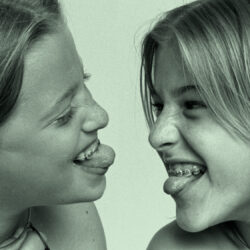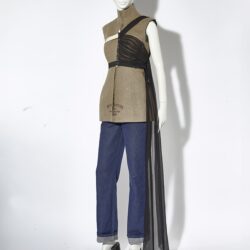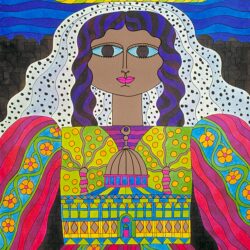Anne Teresa De Keersmaeker: Memories of Clothing and Movement

The exhibition ECHO. Wrapped in Memory explores the intimate connection between clothing and memory through the work of Louise Bourgeois, Simone Rocha and Anne Teresa De Keersmaeker. Clothing has played a crucial role in the choreographies of the latter and her dance company Rosas for forty years. From working with Dries Van Noten to dancing in a transparent dress or a shirt with rolled-up sleeves, for De Keersmaeker many memories are attached to the outfits that helped shape her long-standing dance career.
Is clothing important to you?
ANNE TERESA DE KEERSMAEKER: "Clothing is very important to me as a choreographer. The structure, the materials used, the color, the transparency of a garment, how it responds to or magnifies a movement of the body, for example, which aspect of the dance it emphasizes, … So many different facets of clothing play a role in the choice of costumes. Clothing is an extension of the body."
Can an item of clothing or a pair of shoes become the starting point for a choreography or inspire a dance?
ATDK: "When I dance myself, it often happens that I have the clothes in which I want to dance from day one. In my first pieces, the clothes and shoes were particularly decisive for the choreography. This was the case for Fase, Four Movements to the Music of Steve Reich (1982), Rosas danst Rosas (1983), Elena’s Aria (1984), Bartók / Aantekeningen (1986), … Over the years, this has changed."
Can you give an example?
ATDK: "The Roots shoes we wore in Fase were the starting point for the Clapping Music section of the choreography. We discovered that these shoes allowed us to stand on the tips of our toes. Dancing barefoot or with shoes on, dancing in heavy boots or wearing high heels, … this results in very different movements."
How did your close collaboration with Dries Van Noten start?
ATDK: "Dries Van Noten and I worked together for the first time on Just Before (1997). Subsequently, we collaborated on Drumming (1998), I Said I (1999), Rain (2001) and Raga for the Rainy Season / A Love Supreme (2005). These collaborations were an inspiring learning experience. They provided me with insights into how the creative process of a designer unfolds. I appreciate the craftmanship of Dries Van Noten as well as his modesty and his eye for choreography. These performances were the result of the work of a team: a group of dancers, the music composed by Steve Reich, the set and light design by Jan Versweyveld, and the costumes by Dries Van Noten all developed in dialogue with each other."
How has your approach to costumes changed over the years?
ATDK: "In the early years, there was a continuity between rehearsals and performances. The movements were also inextricably linked to the fact that I myself danced these pieces, which were performed exclusively by female dancers. The moment I only took on the role of the choreographer, and watched what was happening on stage from a distance, the movement vocabulary changed and I started to work with costumes in a different way. I collaborated with different designers and the dynamics are always different. The clothes are purchased or designed. We also take into account the preferences of the dancers. Much like I do not want to impose any movements on the dancers, I also do not want to force them to wear clothes they are not comfortable with. In recent years, we often turned to the existing Rosas clothing stock as a starting point. This approach stems from a minimalist aesthetic but also from an increased ecological and economical awareness. In the last ten years, we are regularly confronted with violent images, films and information about how unecological and unethical the production of clothing can be. I love beautiful clothes. I would even call it a ‘guilty pleasure’. This presents me with a dilemma as a citizen and a consumer."
Rosas, Vocabularium, 2023
One of the videos produced especially for the exhibition is a registration of your entire ‘vocabulary’. Can you describe what it means for you to see your vocabulary come together in this way?
ATDK: "It will not be a registration of my entire vocabulary but of part of the vocabulary from some of the sixty performances created by Rosas in the past forty years. Looking back at it in this way, it’s a very long trajectory. It also reveals the crucial role clothing plays in how a movement is perceived. The video also visualizes the evolution over the years, from dancing in the clothes we wore during rehearsals to the collaborations with various designers."
Another video will show a dancer’s handling of clothing. Can you tell us more about this choreography?
ATDK: "Sola is a video installation inspired by the dress I wore in my first dance solo, Violin Phase. Violin Phase was created in New York City in 1980. The twirling that typifies this choreography was inspired by the movements of the dress and the fabric of which it was made. This basic movement vocabulary - turning, jumping, and walking - was also the starting point for this solo. Sola includes references to Violin Phase, to my very first work Asch (1980), and to my latest solo, The Goldberg Variations (2020). The video, created in collaboration with Ruben Desiere and Olivia Rochette, invites an analytical reading but at the same time it is almost emotional. This ‘romantic’ quality is further emphasized by the music, a recording of Franz Schubert's Fantasia in F minor, performed by Pavel Kolesnikov and Samson Tsoy."
Rosas, Sola, 2023
ECHO. Wrapped in Memory is on view through 25 February 2024. More info and tickets available here








